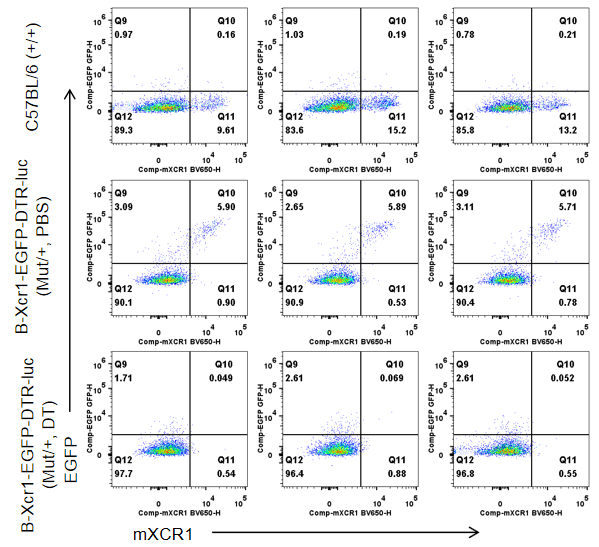B-Xcr1-EGFP-DTR-luciferase mice
| Strain Name | C57BL/6JNifdc-Xcr1tm1(EGFP-DTR-luc)Bcgen/Bcgen | Common Name | B-Xcr1-EGFP-DTR-luciferase mice |
| Background | C57BL/6JNifdc | Catalog number |
112854 |
|
Aliases |
GPR5, CCXCR1 | ||
Description
- B-Xcr1-EGFP-DTR-luciferase mice have the endogenous mouse Xcr1 promoter to determine the expression of DTR (Diphtheria toxin receptor), EGFP (enhanced green fluorescent protein) and luciferase.
- cDC1 cells were traced by EGFP in B-Xcr1-EGFP-DTR-luciferase mice, and could be effectively eliminated after DT administration.
Gene targeting strategy for B-Xcr1-EGFP-DTR-luciferase mice. A construct composed of an internal ribosome entry site (IRES), the cDNA for enhanced GFP (EGFP), the human DTR, and luciferase was inserted at the stop codon of the Xcr1 gene in B-Xcr1-EGFP-DTR-luciferase mice, allowing for EGFP, DTR and luciferase expression and de novo Xcr1 expression.

XCR1+ cells depletion analysis in spleen by flow cytometry. Splenocytes were isolated from wild-type C57BL/6 mice (+/+) and heterozygous B-Xcr1-EGFP-DTR-luciferase mice (Mut/+) (n=3, 8-9-week-old) injected with PBS or DT (50ng per g body weight) for four consecutive days. Flow cytometry analysis of the splenocytes was performed to assess the depletion of XCR1+ and EGFP in total dendritic cells. The frequency of XCR1+ and EGFP cells were decreased in heterozygous mice after DT injection.

Frequencies of cDC1 cells and EGFP+ cells in spleen by flow cytometry. Splenocytes were isolated from wild-type C57BL/6 mice (+/+) and heterozygous B-Xcr1-EGFP-DTR-luciferase mice (Mut/+) (n=3, 8-9-week-old) injected with PBS or DT (50 ng per g body weight) for four consecutive days. Flow cytometry analysis of the splenocytes was performed to assess the frequencies of cDC1 cells and EGFP+ cells in total DC population. The signal for cDC1 cells(A) and EGFP+ cells(B) were decreased in heterozygous mice injected with DT. C. Percentages of cDC1 cells and EGFP+ cells in total DCs. The frequencies of cDC1 cells and EGFP+ cells were decreased in heterozygous mice after DT injection.

Frequency of leukocyte subpopulations in spleen by flow cytometry. Splenocytes were isolated from C57BL/6 and B-Xcr1-EGFP-DTR-luc mice(n=3, 9-week-old). Flow cytometry analysis of the splenocytes was performed to assess the frequency of leukocyte subpopulations. Single live cells were gated for the CD45+ population and used for further analysis. Percentages of NK cells, dendritic cells, granulocytes, monocytes, macrophages in heterozygous B-Xcr1-EGFP-DTR-luc mice were similar to those in the C57BL/6 mice, while the percentage of T cell and B cells showed significant difference between heterozygous mice to those in C57BL/6 mice. Values are expressed as mean ± SEM.












 京公网安备:
京公网安备: